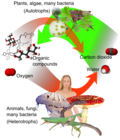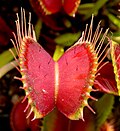Extracellular phototropic digestion is a process in which saprobionts feed by secreting enzymes through the cell membrane onto the food. The enzymes catalyze...
14 KB (1,800 words) - 15:34, 8 April 2024
extracellular environment prior to ingestion of the consequent "soup". In others, once potential nutrients or food is inside the organism, digestion can...
40 KB (4,953 words) - 19:14, 27 March 2024
digestion, called extracellular digestion. In amphioxus, digestion is both extracellular and intracellular. Intracellular digestion is divided into heterophagic...
5 KB (540 words) - 14:49, 29 June 2018
Proteolysis (redirect from Peptidic digestion)
intracellularly or extracellularly. In digestion of food, digestive enzymes may be released into the environment for extracellular digestion whereby proteolytic...
34 KB (4,225 words) - 03:34, 2 April 2024
-proʊ-/ or lysotrophic nutrition is a process of chemoheterotrophic extracellular digestion involved in the processing of decayed (dead or waste) organic matter...
7 KB (757 words) - 19:02, 17 March 2024
Saprotrophs (also called lysotrophs) are chemoheterotrophs that use extracellular digestion in processing decayed organic matter. The process is most often...
27 KB (2,935 words) - 20:11, 6 April 2024
gastrodermis, with a jellylike layer called the mesoglea between. Extracellular digestion takes place within the central cavity of the sac-like body. This...
2 KB (181 words) - 16:45, 23 January 2024
they need while leaving the indigestible waste. This is called extracellular digestion. This is very important in ecosystems, for the nutrient cycle.[citation...
2 KB (186 words) - 18:46, 9 February 2024
undergo autophagy, form foam cells and giant cells, and try to do extracellular digestion in a process called frustrated phagocytosis. Crystals do not always...
8 KB (821 words) - 08:31, 9 October 2023
Ruminant (redirect from Rumination (digestion))
from plant-based food by fermenting it in a specialized stomach prior to digestion, principally through microbial actions. The process, which takes place...
39 KB (3,968 words) - 22:49, 26 June 2024
synthesis of extracellular chitin in exoskeleton, cyst/spore wall, or cell wall of filamentous growth and hyphae; the extracellular digestion of substrates...
20 KB (1,419 words) - 08:46, 18 May 2024
developed stage and then lose their redundant cilia. They feed by extracellular digestion. They were originally thought to feed by suction – hence their...
3 KB (335 words) - 18:24, 15 April 2024
3 ft. in armspan. This anemone exhibits both intracellular and extracellular digestion. Food is caught within the tentacles which then move the prey towards...
9 KB (1,059 words) - 21:59, 24 June 2023
the midgut of most bivalves and some gastropods which aids in extracellular digestion. It consists of a protein matrix coated with digestive enzymes...
2 KB (134 words) - 15:31, 10 September 2023
fungus. Saprotrophic fungi use the process of chemoheterotrophic extracellular digestion involved in the processing of decayed organic matter. They are...
16 KB (1,677 words) - 04:54, 19 April 2024
and a bothrosome-produced ectoplasmic net, which is used for extracellular digestion. Thraustochytrids are morphologically variable throughout their...
104 KB (10,658 words) - 15:08, 11 April 2024
pieces from the walls of the bile ducts. F. hepatica relies on extracellular digestion which occurs within the intestine of the host. The waste materials...
42 KB (4,421 words) - 10:40, 16 June 2024
parasites". Protistologica. 10: 217–222. Gaines G, Taylor FJ (1984). "Extracellular digestion in marine dinoflagellates". J. Plankton Res. 6 (6): 1057–61. doi:10...
96 KB (10,319 words) - 18:59, 29 June 2024
Venus flytrap (section Digestion)
as extracellular pre-digestive oxidants to render membrane-bound proteins of the prey (insects) more susceptible to proteolytic attacks. Digestion takes...
62 KB (6,947 words) - 17:23, 21 June 2024
organelles within the cell. A vesicle released from the cell is known as an extracellular vesicle. Vesicles perform a variety of functions. Because it is separated...
36 KB (3,649 words) - 05:36, 29 June 2024
peristalsis and ciliary action. When the food reaches the coelenteron, extracellular digestion is initiated by the discharge of the septa-based nematocysts and...
39 KB (3,985 words) - 06:10, 12 January 2024
Glossary of biology (redirect from Extracellular)
yellowish-brown fluid, produced by the liver of most vertebrates, which aids the digestion of lipids in the small intestine. Also called gall. binary fission The...
94 KB (11,418 words) - 16:24, 5 March 2024
the habit of growing into their substrates as thin strands for extracellular digestion. This is most typical of the "true" fungi, but it has also evolved...
137 KB (14,804 words) - 12:35, 27 June 2024
Extracellular enzymes or exoenzymes are synthesized inside the cell and then secreted outside the cell, where their function is to break down complex...
45 KB (4,707 words) - 14:07, 11 October 2023
In plants, the extracellular nicotinamide adenine dinucleotide induces resistance to pathogen infection and the first extracellular NAD receptor has...
79 KB (8,992 words) - 01:33, 28 June 2024
Homeostasis (redirect from Extracellular fluid homeostasis)
pre-set limits (homeostatic range). Other variables include the pH of extracellular fluid, the concentrations of sodium, potassium, and calcium ions, as...
80 KB (9,706 words) - 11:40, 26 June 2024
soluble compounds which are capable of being absorbed (digestion). Then the soluble products of digestion for the organism are being broken down for the release...
3 KB (216 words) - 06:15, 20 May 2024
Like all Phallaceae species, C. columnatus is saprobic, and uses extracellular digestion to acquire nutrients from dead and decaying organic matter, like...
16 KB (1,688 words) - 19:52, 11 May 2024
Fat necrosis (section Enzymatic digestion)
various injuries to adipose tissue, including: physical trauma, enzymatic digestion of adipocytes by lipases, radiation therapy, hypoxia, or inflammation...
7 KB (592 words) - 23:18, 16 June 2024






















